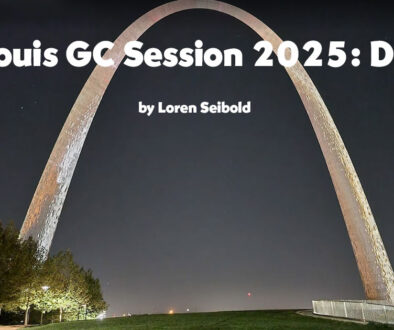#GCAC16, Day Three: The Official Elephant
by Loren Seibold
I could pretend that you’re interested in the business items that were discussed on Tuesday morning, but I know better. You want to know about the discussion of “the paper”.
First, you must recall that there are two papers in this story: one discussed on Tuesday, the other, released a couple of weeks earlier, still lurking ominously in the background. That first, a rambling 70-page history/theology defending the GC’s authority to take extraordinary measures to enforce church uniformity, and a 17-page summary of the same, was called “A Study of Church Governance and Unity”. It defended a strong General Conference that could force compliance in the judicatories below it, and dismissed as inapplicable all warnings about centralized power and the reason for union conferences. It appeared mysteriously from GC offices, and has now just as mysteriously faded away. No one in charge of the meeting mentioned it, or acknowledged its existence when others did. It was treated, as Ellen White said ignorant slaves would be, as though it had not been.
The other, called “Unity in Mission: Procedures in Church Reconciliation” was a product of the week or so that division officers have been meeting with GC officers. This paper preserved the goal of bringing judicatories that were perceived as disobedient into compliance, but was presented as a prayer-infused process of reconciliation.
We heard repeatedly that none of this was about Women’s Ordination, yet there wasn’t a person in the room that believed it. It was all about Women’s Ordination. There is no other departure from policy (if that’s what it is) that is occupying leaders’ minds right now.
Around noon they let us know that there would be a live feed of the discussion starting at 2 PM. Those of you who tuned in at 2 heard a presentation about where the 2025 General Conference Session would be held (St. Louis, MO). Then a presentation by a young woman about how she knitted caps for the homeless.
Was it important that you be informed about GC2025? Or was this about building suspense? Or were there still last-minute negotiations going on in a back room? I can’t say for sure. But do remember that the first rule of controlling a meeting is to use up as much time as possible from the chair, where you have control, so there’s less time for the floor, where you don’t.
The second rule for controlling a meeting is limiting discussion. Although there were a couple of hours of comments, each chopped off abruptly at two minutes. Now, I know as well as anyone that ministers are long winded. Some really do thrill to the sound of their own voices and will preach a whole evangelistic crusade anytime allowed near a microphone. But I found it disturbing that such wise voices as Dan Jackson (NAD president), Jiří Moskala (seminary dean), Andrea Luxton (Andrews University president), Randy Roberts (senior pastor of the University Church in Loma Linda) and others were interrupted by the chair in a rather rude way, not even letting them finish a final word of a sentence.
I will tell you two things about the comments from the floor. First, most of those who spoke were against approving the paper. One supporter made the observation that many were remaining quiet because their English wasn’t good, implying they’d be voting for it. He was prophetic.
Second, so many of the comments against this procedure were just astonishingly good. It made me proud of the good thinkers in our church.
One significant argument, mentioned first by the Jiří Moskala and later by others, was the way the document mashed together fundamental beliefs, doctrine, Biblical principles, working policy and voted policy (like the San Antonio vote on women’s ordination), as though they were all the same thing. (Which may in fact be the unexamined and unstated assumption of some of our leaders.)
A few commenters suggested that this could create a split in the church, or discourage our young people. A mere reconciliation statement could do that, you ask? Well, no. Let’s be clear: the document under discussion wasn’t the only thing that worried them. The shadow of that earlier document, “A Study of Church Governance and Unity” loomed over the session, which had admitted more about how much power the brethren really wanted to exercise than they may have wanted us to know. Many expressed that the mere proximity to the previous 70 page paper with its implied punishment, labeling those out of agreement with them as satanic, and hiding control behind the cause of unity, had raised anxiety so much that we ought to for now abandon another attempt until the adrenaline was flushed from our system.
Others said this paper was just too fresh, too undeveloped, that it had been rushed into place and needed to be sent back for revision. While those up front insisted that they were listening and recording and noting all the comments, what good does that do if they’re planning on asking the group to accept it just as it is? Don’t count on the excellent criticisms of this paper being incorporated into it. They can’t be without more voting, and the meeting is over. Someone genuinely interested in unity would have said, “It sounds like we’re not going to get a strong vote on this, so rather than ask you to approve it today, let’s send it back to incorporate some of these suggestions.”
Others made the religious liberty argument, that freedom is the foundation of faith; that force is a poor way to develop unity in matters of conscience; that there’s room for differences in some areas of faith and practice.
A few made the accurate observation that there was already a procedure for doing this in the working policy now. Why another one? What was added yesterday is a year of prayers and meetings and letters between Ricardo Graham and the brethren, and Dave Weigley and the brethren, that isn’t going to convince anyone. (One commenter, Ron Carlson from Kansas-Nebraska Conference, said, “Do we really need a procedure to give us permission to talk and pray together?)
Others said that the number of places this could be applied were so numerous that it would completely swamp the church were every breach of policy to be pushed through the sieve of this procedure, with all its prayer and meetings and letters of warning. To this, no one had a good answer, which is an admission that the whole crisis has been designed for one purpose only: to turn over their knee for a spanking those unions that have ordained women. Lacking that issue, none of this would have been necessary, protestations notwithstanding.
The argument that I would have made, had I been been important enough to speak, was it is very unwise to implement an unfinished, open-ended document. The chairman kept saying, “We’re only talking about the procedure here. Were not today talking about the consequences if the procedure doesn’t work. We’ll talk about that later.” How in heaven’s name can you vote a process without a goal? Would you find it acceptable if a government passed a law about how to investigate and bring to trial a newly-defined crime, but said, “Let’s leave the punishment undecided for now. We may have no consequences at all, we may have a $5000 fine, or we may impose the death penalty. But don’t worry about that now. Just give us a blank check to go through this procedure, and we’ll tell you later what we plan to do if we find someone guilty.”
Guilt, you ask? Investigation, accusation, and punishment? The argument from the chair was that we shouldn’t get so worked up: it’s just an innocent procedure to implement Matthew 18! Nope: this is at core a legal process. It’s the religious version of arbitration. The higher organization accuses a lower one of breaking policy, and hides forced compliance behind prayer and study. People could lose jobs. Church members will get discouraged. At least one conference president could be forced out of her job, and many female pastors will be alienated from what God has called them to do. Here are life-changing consequences masquerading as sweet spiritual concourse between brethren.
Many said that we are messing about with an unnecessary procedure when we should be focused on our vision; that arguing over policy was indicative of a church in the final stage of its life cycle, when it has lost its vision and is now only focused on conformity; that we are talking about enforcing policy unsuitable for many parts of the church, when we should be concentrating on making policy that is customized for different parts of the church.
Those for the paper all had a similar argument: something was voted at San Antonio, and there’s nothing else to talk about. The decision is made. You obey. (So much for the claim that this had nothing to do with women’s ordination. That’s pretty much all it was about.) Jay Gallimore called it “pluralism” for some to think that they should operate by different policies than others.
And so Elder Wilson won the vote: 169 yes (56%), 122 no, (40%) with a few abstentions. The only surprising thing to me is that it was as close as it was. Another win-lose situation, with a disturbingly narrow margin. And it’s the church that will lose, as we fight about something that could have been win-win with a tiny bit of flexibility.
At the end, Elder Wilson said it wasn’t a witch hunt. He said there were several (unspecified) actions taken by the church in session that he’s disapproved of since he’s been president, but he didn’t fight against them. And he again invoked unity: God’s church will stay united to the end, he said.
This elephant isn’t gone. It’s going to be popping into governance meetings around the world for the next year. The process, with its unspecified consequences, will be invoked first for those unions that have ordained women. It may come up at other times—selectively, to be sure, since there are many judicatories and institutions that are out of policy in some way or another—when a church entity appears to be exercising independence from the GC.
“But it was voted by the church,” they’ll say.
True. But not by the part of the church that it affects the most.




